Drawings by the Young Quillard
© Martin Eidelberg
Created June 2022
© Martin Eidelberg
Created June 2022
A half century ago I explored the artistic origins of Pierre Antoine Quillard (c. 1704-1733), the fascinating but problematic pupil of Antoine Watteau, and I particularly focused on his early drawings and the clues that they offered in uncovering the first stages of his development.1 In 1981 I returned to the subject and again investigated his early drawings and their significance.2 During this time, closely related works came to light and also the attributions of some of the principal drawings have been challenged. Enough scholarship has accumulated to warrant a fresh and wider appraisal of the situation.
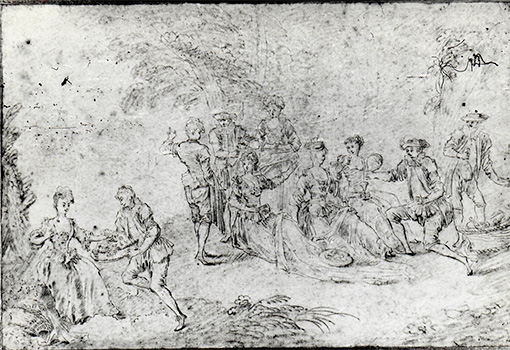 |
5. Quillard, A Picnic, red chalk, 21.3 x 32.2 cm. Chatsworth, collection of the Duke of Devonshire. |
Fundamental to any study of Quillard’s early drawings is a series of distinctive studies from the earliest phase of his career, drawings that highlight his relationship with Watteau. Central to the issue are five sheets in the collection of the Duke of Devonshire at Chatsworth (figs. 1-5). These were acquired by either William, 2nd Duke of Devonshire (1673-1729) or, more likely, William, 3rd Duke of Devonshire (1698-1755). Although the drawings were attributed to Watteau in the eighteenth century, this means little since so many French paintings and drawings in the style of Watteau, whether autograph or copies, were falsely or mistakenly given to the master, especially those that came across the Channel. Indeed, in 1740 the 3rd Duke of Devonshire also bought two paintings wrongly attributed to Watteau. They too are still at Chatsworth.
Although preserved in England, far from the eyes of most French scholars, the Chatsworth drawings were not entirely unknown. In his 1896 monograph on Watteau, the Danish scholar Adolf Rosenberg illustrated two of them, predictably under the name of Watteau (figs. 1, 2).3 A few years later, in 1903, Virgil Josz extolled the lyrical, Fragonardesque quality of the Chatsworth drawings (a description not at all apt) and, of course, he too believed that they were by Watteau.4 Two decades later, in 1925, the Vasari Society of London published facsimiles of one of the Chatsworth drawings, still under the name of Watteau (fig. 3).5 These scattered instances, however, probably went unnoticed by most.
The five Chatsworth drawings did not come into prominence until the late 1920s when Dacier, Vuaflart, and Hérold published three of them as the work of Quillard (figs. 1, 2, 3).6 They based their attribution on the similarities to a signed Quillard drawing in the Louvre. And they reasonably argued that although there are few Quillard drawings, the signature on the Louvre sheet was trustworthy since there would have been no stimulus to add the name of an otherwise obscure, essentially unknown artist. Strangely, they did not mention the other two Quillard drawings in the Devonshire collection. Equally curious, the attribution of any of the Chatsworth drawings to Quillard was largely ignored by the many scholars who were interested in this artist but who primarily focused on his paintings.7
Scholars’ disinterest in Quillard’s drawings was offset by the art market, which was excited by the discovery of a new Watteau disciple. “Quillard” offered a convenient haven for otherwise anonymous copies after the master, and for drawings that were “école de Watteau” but could not be ascribed to Jean-Baptiste Pater, Nicolas Lancret, or other, known Watteau satellites.
Despite the numerous drawings that have been given to Quillard since the last third of the twentieth century, often with misplaced enthusiasm, it may be more productive to focus on the considerable corpus of drawings from his first years that have come to light. These drawings, more plentiful than has perhaps been realized, are remarkably uniform in style and mark the first stage of Quillard’s development. The five Chatsworth drawings forming the central core show slight variations in their overall organization, but their formats correspond in important ways to the drawings we are about to consider. Two of the Chatsworth drawings are compositional studies that fill the sheet, although one is fan-shaped rather than rectangular (figs. 4, 5). Another two of the Chatsworth sheets are divided into four equal compartments, each containing a full composition (figs. 2, 3). Last, one page has two horizontal ranges, the upper one with a compositional study and the bottom one with a row of seven figures (fig. 1). These formats—full compositions, fan-shaped fields, quadripartite cells, and rows of individual figures—prove to be Quillard’s standard page layouts.
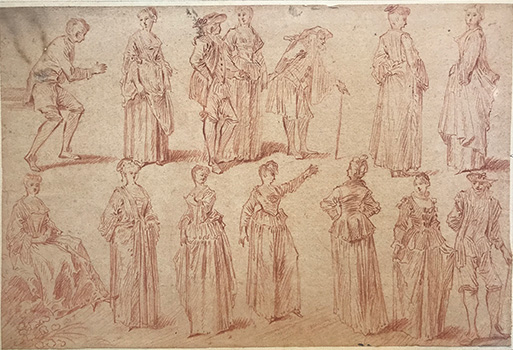 |
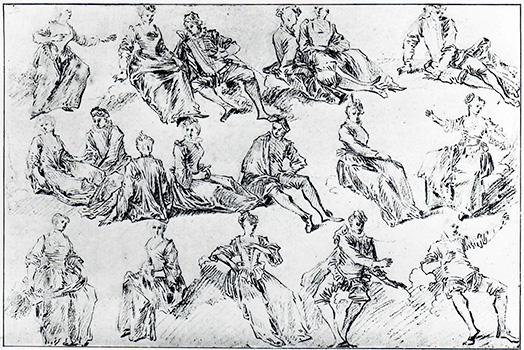 |
6. Quillard, Sheet of Studies, red chalk, 20.5 x 30.5 cm. Los Angeles, collection of Ariane and Lionel Sauvage. |
7. Quillard, Sheet of Studies, red chalk. Whereabouts unknown. |
Two other Quillard sheets have just horizontal rows of figure studies—the first with two rows, the other with three rows (figs. 6, 7). They unmistakably resemble the bottom portion of one of the Chatsworth sheets that has been discussed (fig. 1). I published these two sheets in 1970, quite confident of the attribution because of their distinctive graphic resemblance to the Chatsworth drawings and their distinctive mise-en-page. This strict line up of characters is related to a formula employed by Claude Gillot and his shop, and then was continued in several of Watteau’s early drawing. It is a scheme that can probably be attributed to the artists working from their imagination or copying already established types rather than drawing from live models; the latter process normally results in a freer, more organic layout. Indeed, as I have previously demonstrated, in these drawings Quillard was copying Watteau drawings.
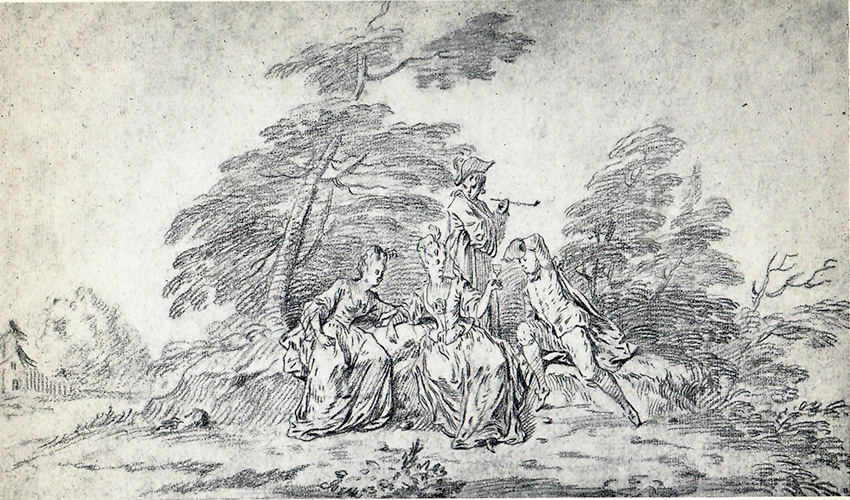 |
8. Quillard, Four Figures Smoking and Drinking, red chalk, 15.1 x 26.1 cm. Whereabouts unknown. |
Additionally, two full-page compositions should be added to this ensemble. The first is a fête galante with four figures centered in a wide landscape (fig. 8), a formula that Watteau never used. One of the women holds out a glass to a man who eagerly pours wine into it. Behind the group stands a man smoking a long clay pipe and here again Quillard departs from his master, who never portrayed smoking except in scenes of military camps.
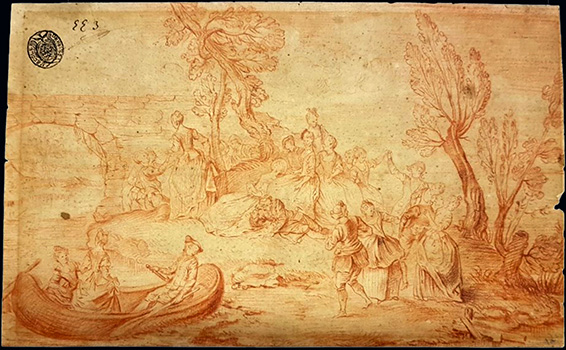 |
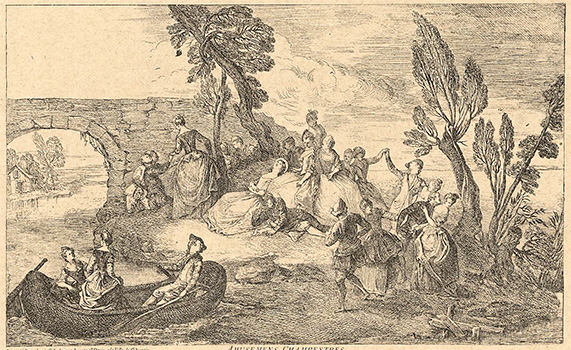 |
9. Quillard, Amusements champêtres: La Barque, red chalk, 18.2 x 29.5 cm. Reims, Musée des beaux-arts. |
10. Quillard, Amusements champêtres: La Barque, etching. |
If the previous scene is relatively simple, the next drawing is richly complex, with a great many people involved in a series of activities (fig. 9). In addition to the eleven people on an island sitting and standing in poses customary in fêtes galantes, a group of eight figures dance energetically, forming a chain that snakes around the water’s edge. At the opposite side, a man vigorously rows a boat with two ladies toward the island. The graphism of this drawing matches that on the others considered thus far. But whereas all those drawings are essentially studies made without known purpose, the Reims sheet fulfilled a specific function: it established the design for a print that was issued in Paris. (fig. 10).
Several more Quillard drawings have come to light since my initial publication in 1970, from diverse sources but all attributable to Watteau’s young pupil. One, which first appeared at a London auction in 1987, is a fully resolved fête galante with the unusual motif of a falconer at the right (fig. 11). Set within an arch, its fan-shaped format recalls one of the pages at Chatsworth (fig. 4) and it is close in measurements to that sheet, but its figures are more numerous and are drawn on a smaller scale. Another recent arrival is also a full fête galante, one that fills the rectangular field of the page (fig. 12). It features a woman guitarist serenading a group of well-dressed members of society, but at the right side the onlookers wear commedia dell’arte costumes. When it first appeared on the London market in 1979 it bore an improbable attribution to Claude Gillot, but it is clearly by Quillard.8
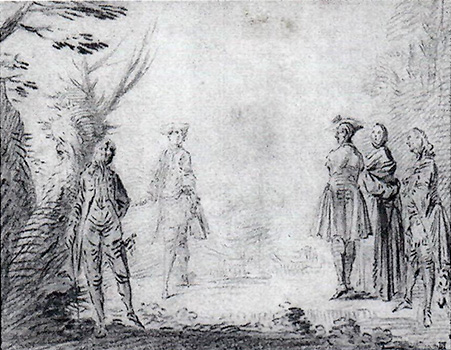 |
13. Quillard, Five Figures Standing in a Clearing, red chalk, 14.5 x 18.5 cm. Whereabouts unknown. |
A compositional study of Five Figure Standing in a Clearing has been known since the 1930s but only via a murky photograph (fig. 13).9 Its reemergence in 2007 has given us a clearer, more accurate sense of its appearance and confirms its stylistic relation to the Quillard drawings already adduced.
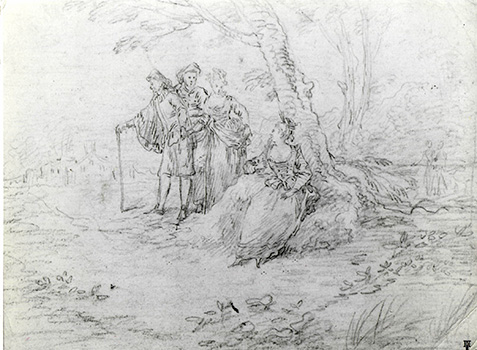 |
14. Quillard, Fête Galante with a Wedding Procession, red chalk, 16 x 21.2 cm. New York, private collection. |
Another pertinent compositional study is now in a New York private collection (fig. 14). It is of interest on several scores. First, of course, its graphic characteristics—stiff postures, claw-like hands—are closely related to what we see in all the other Quillard drawings. Perhaps not coincidentally, in the nineteenth when it was in the collection of Sir William Richard Wallace (1817-1890), it was joined by another Quillard drawing, Five Figures Standing in a Clearing (fig. 13). Although it bore an attribution to Watteau at that time, and more recently the Galerie Cailleux and Marianne Roland Michel sought to retain that ascription on several occasions, the overwhelming evidence points away from Watteau and in favor of Quillard.10 Significantly, the bridal procession in the background is a variation on a motif that Quillard had previously copied more faithfully from Watteau; see the grouping at the top center of the sheet in the Sauvage collection (fig. 6). But this second time, Quillard created a variation on the theme, transposing the lovers, modifying their poses, and adding the seated woman who now dominates the scene.
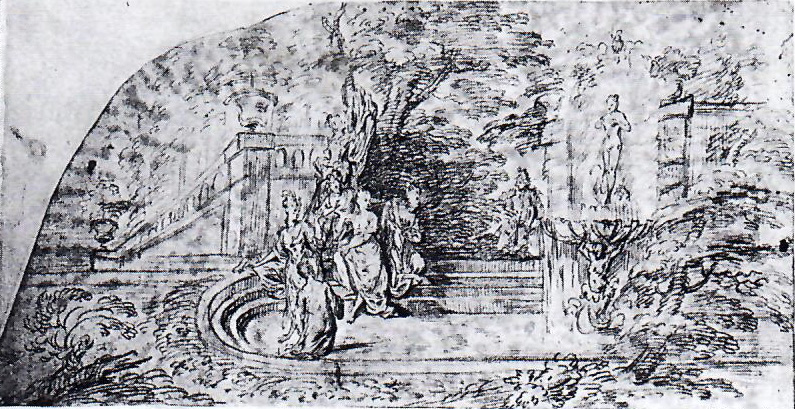 |
15. Quillard, Fête in a Garden, red chalk with traces of graphite, 18.5 x 36.7 cm. Whereabouts unknown. |
Another full composition by Quillard appeared on the London market in 1982 with an ascription to the “Circle of Jean Antoine Watteau,” but with the observation that “an attribution to Quillard has been suggested” (fig. 15).11 Indeed, he is the artist responsible. Although the arched shape at the left suggests analogies with the two fan-shaped designs by Quillard discussed above, in this instance the resemblance is fortuitous. The artist originally drew the scene in a standard rectangular format as is shown at the right, where the strokes of chalk stop short of the edge of the paper. But at the left side, the strokes extend beyond the present edge, establishing that the page was trimmed to its present arched form at a later date, whether by Quillard or someone else. Nonetheless, the draftsmanship of the composition establishes its close relationship with the Chatsworth set and all the other drawings that we have discussed above.
Although we lack information about the early provenance of most of the drawings discussed here, it is significant that like those in the Chatsworth set, three of the sheets can likewise be traced to England in the early eighteenth century. Four Figures Smoking and Drinking (fig. 8), Five Figures Standing in a Clearing (fig. 13), and the Fête Galante with a Wedding Procession (fig. 14) all bear the collector’s mark of Jonathan Richardson Jr. (1694-1771). The inference is that a substantial number of Quillard drawings, including those at Chatsworth, early on found their way across the Channel, possibly a single set which was then broken down into smaller lots. Undoubtedly, they all were marketed under Watteau’s name.12
Adding to the probability that these drawings were once a set, perhaps an album, is their medium: they all are in red chalk, occasionally with traces of graphite but without black chalk, much less with the trois crayons associated with Watteau’s mature works and used by some of his followers. Also they are relatively unform in size. The five Chatsworth drawings measure approximately 21 x 32 cm, with only one sheet slightly larger, by 3 cm in width. The other Quillard drawings presented here vary more but not considerably. Some measure only 15 cm in height, but most are 18 to 20 cm. Except for two, most of the sheets are just under 30 cm. in width. Given that the drawings were widely dispersed, one has to make allowances for the minor trimming of edges that occurred here and there.
When I published my 1970 essay on Quillard’s drawings, one of my principal observations was that these studies, both the rows of individual figures and some of the compositional groupings, were essentially copies or variations after Watteau drawings and paintings. Moreover, the extensive number of these instances support the inescapable conclusion that Quillard had studied with Watteau and that he had been his master’s assistant for an extended period of time, probably around 1715. This conclusion still stands.
The sheet in the Sauvage collection is a good case in point (fig. 6). On the top line, at the far left, a seated man turns to the side (fig. 16). This figure was based on a lost Watteau drawing known through a copy in Rennes (fig. 17),13 and he also appears in Watteau’s Fêtes vénitiennes (fig. 18). These comparisons underscore how faithful Quillard could be as a copyist, but only when he chose to.
The middle three figures in the top row of the Sauvage drawing (fig. 19) can be traced to a Watteau compositional drawing, the counterproof of which is now in the National Gallery of Art, Washington (fig. 20). Here again, Quillard was faithful to his model save that he did not include the landscape setting that Watteau had provided.
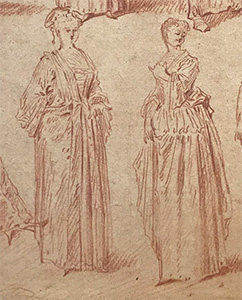 |
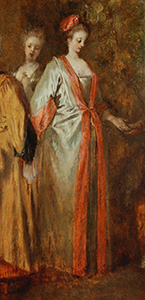 |
21. Quillard, Sheet of Studies (detail of fig, 6), Los Angeles, Sauvage collection. |
22. Watteau, Diseuse d’aventure (detail), Los Angeles, collection of Ariane and Lionel Sauvage. |
The two women second and third from the left in the bottom row of the Sauvage sheet (fig. 21) were based on a lost Watteau drawing that the artist used for his painting, Diseuse d’aventure (fig. 22). In the original Watteau drawing, the woman with her hand to her breast was probably at the right and the other was alongside, to the left. In the painting, Watteau moved the woman with her hand to her breast to the left and slightly back. As is evident, Quillard’s copy is based on Watteau’s initial drawing and not his final painting.
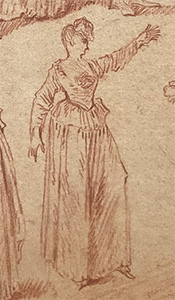 |
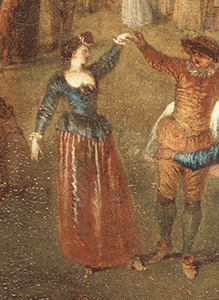 |
23. Quillard, Sheet of Studies (detail of fig. 6)). Los Angeles, Sauvage collection. |
24. Watteau, Comédiens sur le champ de foire (detail). Potsdam, Schloss Sanssouci. |
Likewise, the woman at the center bottom of the Sauvage drawing (fig. 23) copies another lost Watteau drawing. It is the one that Watteau used for a dancer in the foreground of Comédiens sur le champ de foire, an important early Watteau painting (fig. 24).
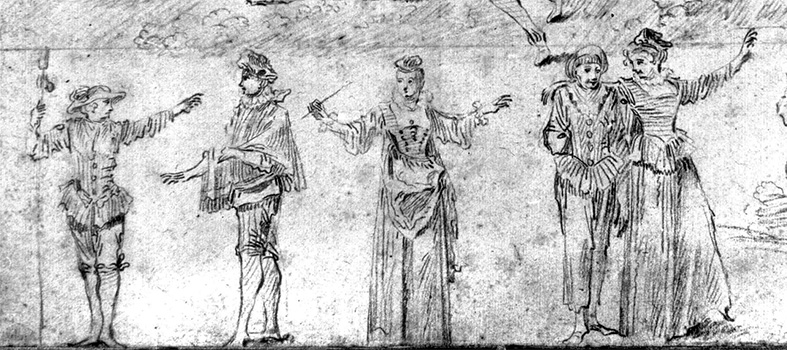 |
25. Quillard, Sheet of Studies (detail of fig. 1). Chatsworth, collection of the Duke of Devonshire. |
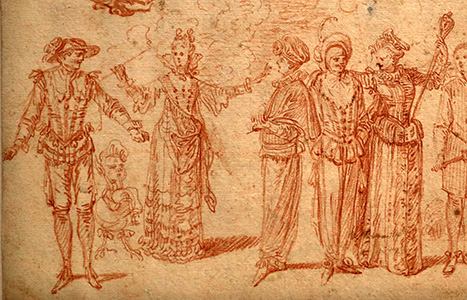 |
26. Watteau, Studies of Theatrical Characters (detail), red chalk. Darmstadt, Hessisches Landesmuseum. |
At times Quillard was more of a creative copyist, changing the sequence of figures and modifying poses at will, as in the case of five theatrical characters in one of the Chatsworth sheets (fig. 25). This ensemble was based on a series of theatrical personages on a Watteau drawing now in Darmstadt (fig. 26), but Quillard introduced many changes.14 First, he changed the pose of the man at the left by repositioning both arms. Then he jumped to Watteau’s third character, an actress with both her arms raised and holding a small baton—all of which he repeated faithfully. But he modified her costume slightly. Then he skipped back to Watteau’s second actor, and here he transformed almost everything save for the face seen in profile and the position of the legs; Quillard’s rendering of the costume and the position of the man’s arms are not at all like Watteau’s model. Quillard returned again to Watteau’s drawing to borrow the figures of a male and female comedian; however, he eliminated the woman’s jester staff and, instead, left her arm extended up into the air, as if she were making a meaningful gesture. Were the Darmstadt drawing not extant, we would be unable to reconstruct it from Quillard’s “copy.”
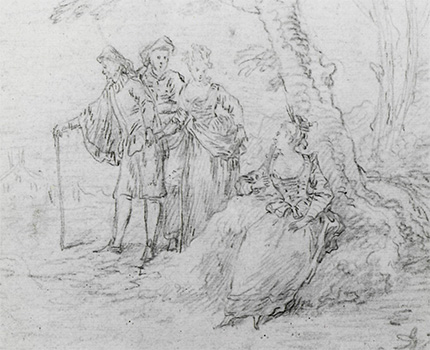 |
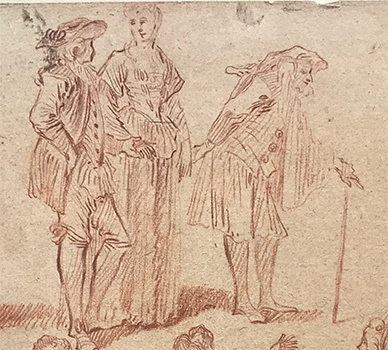 |
27. Quillard, Fête Galante with a Wedding Procession (detail of fig. 14). New York, private collection. |
28. Quillard, Sheet of Studies (detail of fig. 6). Los Angeles, Sauvage collection. |
The Quillard drawing in a New York collection discussed above demonstrates how the artist reconfigured his copies after Watteau to create essentially new images (fig. 27). The New York sheet portrays a seated woman in the foreground looking back to bridal procession led by an old man leading a pair of young lovers. As already discussed, this procession is closely related to a vignette on the sheet of studies in the Sauvage collection (fig. 28) which, in turn, is a relatively faithful copy of a Watteau composition (fig.20). At each stage Quillard introduced modifications. The old actor in the Sauvage study is less bent over than he is in Watteau’s rendering but, that aside, Quillard introduced few modifications. However, quite the opposite is true when we consider the New York rendering. Here the young lovers have exchanged places with each other, and their poses are quite different than Watteau had designated. Whereas they looked lovingly at each other in Watteau’s drawing and in the Sauvage copy, they now look across at the woman seated in the foreground, a figure that Quillard inserted on his own. Although many of the individual parts may be indebted to Watteau, the whole of Quillard’s composition is new and different.
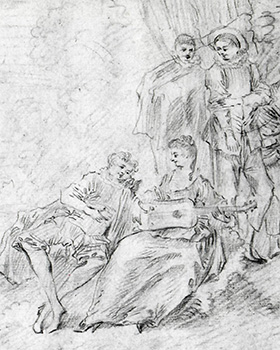 |
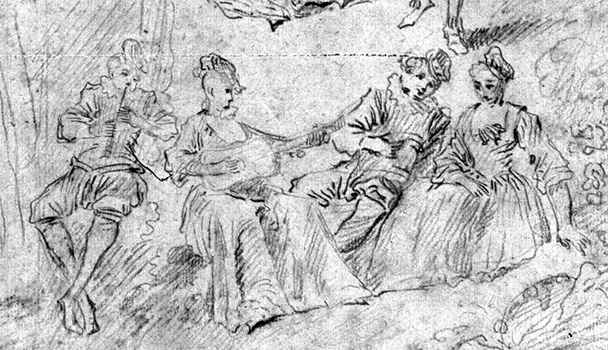 |
29. Quillard, Fête Galante with a Woman Playing a Guitar (detail of fig. 12). Ex-London market. |
30. Quillard, Sheet of Studies (detail). Chatsworth, collection of the Duke of Devonshire. |
Similarly, a Quillard composition that appeared on the London market a few decades ago (fig. 29) stems from Watteau-inspired motifs on one of the Chatsworth sheets (fig. 30), but they have been reworked into something new. The woman strumming the guitar can be traced to the musician, also seated in profile, on the Chatsworth sheet, reversed here and with modifications in the details of her costume. Her ardent lover, inclined toward her and gesturing with his hands, appears to have been based on the man seated to the right of her on the Chatsworth sheet, but the position of his legs, crossed at the ankles, is derived from the man seated to the left of her. A comparable system of assembling and reassembling elements lies behind the other figures in Quillard’s new composition.
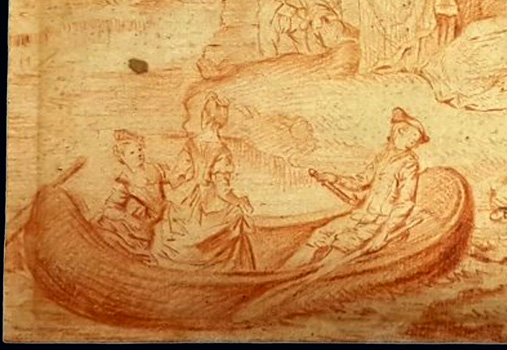 |
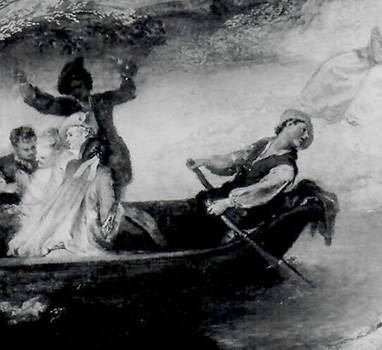 |
31. Quillard, Amusements champêtres: La Barque (detail). Reims, Musée des beaux-arts. |
32. Quillard, L’Île de Cythère (detail).New York, private collection. |
As one explores Quillard’s oeuvre, it becomes apparent that his pictorial language is rich but also formulaic. Individual figures and entire vignettes figure in some works and reappear in others, sometimes unchanged and other times greatly modified. To cite one telling detail, consider the man rowing the boat in the foreground of the Reims drawing (fig. 31). As he pulls on the oars, he turns his head to look over his shoulder, assessing the distance to land. A similarly awkward posture is struck by the oarsman in Quillard’s painting, L’Île de Cythère (fig. 32). Not only does this confirm the manner in which the artist worked but also the attribution of the painting to Quillard helps confirm the attribution of the drawing to him, and vice-versa.
Likewise and in a broader context, one might consider the chains of dancers that wind around in several of Quillard’s works. They too are related to Watteau, who depicted such festive dancers in his Contrat de mariage in the Prado, a painting in which the young Quillard executed some of the background figures (fig. 33). Similar lines of dancers, twisting and gesticulating freely, appear in Quillard’s drawing in Reims (fig. 34) and in many of his paintings such as a fête galante that was once with the Galerie Cailleux (fig. 35). Watteau, despite his one-time use of this motif in the Prado painting, was not that fond of this motif whereas Quillard made frequent use of it to enliven the foregrounds of his paintings. This and other fascinating threads of continuity run throughout Quillard’s oeuvre and help links his early and later works, and bring together his drawings and paintings in a meaningful way.
The strong bonds between Quillard’s drawings with each other and with his etchings and paintings is what we would expect in any artist’s works. This notwithstanding, there have been two attempts to disassociate some or all of these drawings from Quillard’s oeuvre. The first and strongest objections have come from Margaret Morgan Grasselli, who on several occasions proposed that the Chatsworth drawings were not by Quillard but, instead, were by the young Pater (and some by Watteau!).15 Grasselli claimed that the mannerisms of the Chatsworth drawings—“the jumpy contours, the steeply slanted eyes, the emphasis on surface effects, the quality of form”—are closer to the graphism of Pater. However, the fuller, more three-dimensional quality of Pater’s figures is quite different from the extremely flat, agitated renderings of the Chatsworth characters. Complicating matters further, after accepting the attribution to Quillard of A Falconry Party (fig. 11), a few years later she changed her opinion and proposed instead that this sheet, which she by then had acquired for the National Gallery, was executed by Watteau.16 In addition, she singled out the Chatsworth fan design (fig. 4) and attributed that to Watteau as well.
If in 2000 Grasselli reaffirmed her attribution of the remaining Chatsworth drawings to Pater, the following year admitted that she suffered a “frisson of doubt“ about giving A Falconry Party to Watteau.17 She argued that the agreement of size and fan-shaped format between the Chatsworth and Washington drawings was only coincidental, which hardly seems reasonable. Moreover, she withdrew the attribution of A Falconry Party from Pater and instead associated it with two other Quillard drawings, Four Figures Smoking and Drinking (fig. 8) and Fête Galante with a Woman Playing a Guitar (fig. 12). Apparently she did not think they were by Quillard or Pater, but she failed to offer an alternative attribution. Grasselli’s approach has been highly subjective, relying solely on her connoisseurship. But her tactic is built on shifting sand. She made no attempt to link these drawings with Pater’s and Watteau’s other works, and she did not consider the ramifications for all the other drawings in this group. The visual similarities between them and their occasional interdependence argue against subdividing them into separate groups. Her reattributions, rather than bringing order to the field, have led to an unfortunate chaos.
Another voice opposing an attribution to Quillard came from Pierre Rosenberg and Louis-Antoine Prat. They apparently would divide the drawings under discussion among several hands, with equally confusing results. They accept an attribution to Quillard of four of the Chatsworth drawings: three of the sheets of studies (figs. 1, 2, 3) and the Picnic (fig. 5). They outrightly reject Grasselli’s attribution of any of these drawings to Pater.18 However, like Grasselli, they separate out the Chatsworth fan-shaped design with a pastoral subject (fig. 4) and link it with A Falconry Party (fig. 11), giving both to Watteau himself.19 They also opine on several of the other drawings in our series, limiting themselves to only those that in the past have been ascribed to Watteau. Thus they describe Four Figures Smoking and Drinking (fig. 8) as “proche d’Antoine Quillard.’20 Although they acknowledge that I gave the Five Figures Standing in a Clearing (fig. 13) to Quillard, Rosenberg and Prat classify it only as “français, vers 1730.”21 Similarly, they recognize Fête in a Garden (fig. 15) as having been attributed to Quillard but they do not offer any conclusion.22 However, they do accept the Fête Galante with a Wedding Procession (fig. 14) as “seeming” to be by Quillard,23 and they also list A Fête Galante with a Woman Playing a Guitar (fig. 12) as being by Quillard.24 Theirs is a curious game of hit and miss. Like Grasselli, they have not considered the totality and integrity of the oeuvre.
Rosenberg and Prat’s hesitancy in relation to Quillard is a stance not merely restricted to these drawings. It originates from a larger context. Rosenberg and those associated with him at the Louvre have shown a curious reluctance to accept the artist in general. The Louvre still questions the two Quillard paintings in its collection—the same paintings that started the Quillard controversy in the 1920s. Although the Louvre won its case in the French courts a century ago, they still only half-heartedly credit Quillard with their execution: “attribué à Quillard.”25 Likewise, even though the Flutist in the Uffizi is universally recognized as a Quillard, Rosenberg has preferred to present it as “Circle of Antoine Watteau.”26 Thus their vagueness in regard to many of the drawings is understandable.
Given the fractured nature of this state of affairs, it is not surprising that still other scholars have voiced slightly different viewpoints. Roland Michel, for example, rejected the attribution to Watteau of the Chatsworth fan drawing and the National Gallery’s A Falconry Part, and gave both back to Quillard.27 As though oblivious to all the controversy, Alan Wintermute accepted the Chatsworth drawings en bloc, but in response Perrin Stein yet again raised the spectre of Grasselli’s attempted attribution to Pater.28 In his recent study of Quillard as a draftsman, Axel Moulinier likewise side-stepped most of these issues and accepted the Chatsworth drawings.29
As the dust settles, hopefully scholars will recognize the unity of all the Quillard drawings under discussion here, and will push forward in integrating them within his oeuvre. The transition from these early works to his later, mature works opens an avenue worth exploring as we try to chart the evolution of Watteau’s engaging but problematic pupil.
NOTES
1 Martin Eidelberg, "P.A. Quillard, an Assistant to Watteau," Art Quarterly, 33 (1970): 39-70.
2 Idem, "Quillard as Draughtsman," Master Drawings, 29 (Spring 1981): 27-39.
3 Adolf Rosenberg, Antoine Watteau (Bielefeld and Leipzig: 1896), figs. 74, 83. Although illustrated, they were not discussed in Rosenberg’s text.
4 Virgil Josz, Antoine Watteau (Paris: 1904), 131.
5 The Vasari Society for the Reproductions of Drawings by Old Masters, second series (London: 1925): 6: 11, no. 25.
6 Émile Dacier, Albert Vuaflart, and Jacques Hérold, Jean de Jullienne et les graveurs de Watteau au XVIIIe siècle, 4 vols. (Paris: 1921-29), 1: 171-73. Despite the enumeration, the first volume was published last, in 1929.
7 Among those who bypassed the Chatsworth drawings (and Quillard’s drawings as a whole) are Georges Wildenstein, André de Hevesy, Jean Guiffrey, A. Ayres de Carvalho, José de Figuerido, and Jean-Claude Messelet. A notable exception is Victor Alvin-Beaumont, Le Pedigrée, erreurs et verités en art: Autour de Watteau (Paris: 1932), 56-58.
8 London, Christie’s, July 10, 1979, lot 163.
9 The drawing reappeared in Bern, Dobiaschofsky Auktionen, November 9, 2007, lot 338. Although it has been previously published several times in the context of Quillard’s oeuvre, in 2007 it was still classified as “circle of Antoine Watteau.”
10 Sale, London, Christie’s, collection of Sir William Richard Drake, May 24-25, 1892, lot 411. Paris, Galerie Cailleux, Watteau et sa géneration (1968), cat. 24. Also, Galerie Cailleux, Oeuvres de jeunesse de Watteau à Ingres (1985), cat. 43. An attribution to Quillard was first proposed in Eidelberg, “Quillard as Draughtsman,” (1981), 31.
11 London, Christie’s, March 23, 1982, lot 109.
12 Equally tantalizing is another Quillard drawing with an eighteenth-century English provenance. Now in the Polakovitz collection at the École nationale supérieure des beaux-arts, PM 69, it too can be traced to William Esdaile (1758-1837), the late eighteenth- and early nineteenth-century collector of prints and drawings. However, the draftsmanship of this sheet seems looser than that of the others under discussion here, and may represent a slightly later moment in the artist’s career.
13 For the Rennes drawing, see Pierre Rosenberg and Louis-Antoine Prat, Antoine Watteau, Catalogue raisonné des dessins, 3 vols. (Paris: 1996), 3: cat. R 720.
14 For the Darmstadt drawing, see Rosenberg and Prat, Watteau, Catalogue raisonné des dessins, 1: cat. 113.
15 Margaret Morgan Grasselli, The Drawings of Antoine Watteau, Ph.D. thesis (Cambridge: Harvard University, 1987), 223-24; idem. “Eighteen Drawings by Watteau: A Chronological Study,” Master Drawings, 31 (1993), 106.
16 Grasselli, “Eighteen Drawings by Watteau,” 106.
17 Margaret Morgan Grasselli, review of Pierre Rosenberg and Louis-Antoine Prat, Antoine Watteau, Catalogue raisonné des dessins, in Master Drawings, 39 (Fall 2001), 318.
18 Rosenberg and Prat, Watteau, Catalogue raisonné des dessins, 3: cat. R 112-15.
19 Ibid., 1: cat. 143-44.
20 Ibid, 3: cat. R 17.
24 Ibid, 3: under cat. R 112.
25 See Pierre Rosenberg, Nicole Reynaud, and Isabelle Compin, Musée du Louvre. Catalogue illustré des peintures. École française, XVIIe et XVIIIe siècles (Paris: 1974), cat. 698-99. Also Isabelle Compin and Anne Roquebert, Catalogue sommaire illustré des peintures du Musée du Louvre et du Musée d’Orsay (Paris: 1986), 4: 157.
26 See Pierre Rosenberg et al., Pittura francese nelle collezioni pubbliche fiorentine (Florence: 1997), cat. 133.
27 Marianne Roland Michel, “The Rosenberg-Prat Catalogue of Watteau’s Drawings,” Burlington Magazine, 140 (November 1998), 749-50.
28 Alan Wintermute, ed., Watteau and His World, French Drawing from 1700 to 1750, exh. cat. (New York: Frick Collection, and Ottawa: National Gallery of Canada), cat. 78. Perrin Stein, review of Watteau and His World, in Master Drawings, 39 (Autumn 2001), 337.
29 Axel Moulinier, Les Satellites de Watteau (Paris: 2020), 27-32.